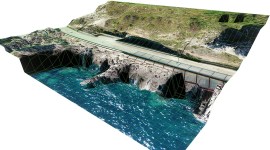
Why You Want to Use Both SSD and HDD for Video Storage
Video editing computers need plenty of space, but they also need to be fast. Let’s explore the benefits of SSD and HDD storage for video.
The first-ever hard disk drive (HDD) was manufactured by International Business Machines (IBM) in 1956. The IBM 350 was a disk storage drive that worked with IBM’s 305 RAMAC (Random Access Memory Accounting) system, which was one of IBM’s last vacuum tube systems.
According to an archive page on IBM’s website, the 350 was sixty inches long, sixty-eight inches high, and twenty-nine inches deep. These days, a drive that large could hold terabytes upon terabytes of data. But back then, the 305 had a measly 3.5MBs of storage capacity — for reference, that would barely fit a JPEG image file.
After hard disk drives reached consumer PCs in the 80s, the technology was still too expensive, so most manufacturers opted for floppy disks, which had to be changed out for every different program. In the 90s, the HDDs began to drop in price, and manufacturers settled on the 3.5-inch and 2.5-inch drives, though not for long.
After reaching peak sales in 2010, the HDD is still around, but it’s been surpassed by the much faster and more expensive SSDs. While both drives have their advantages, I recommend that computers use both drives simultaneously.
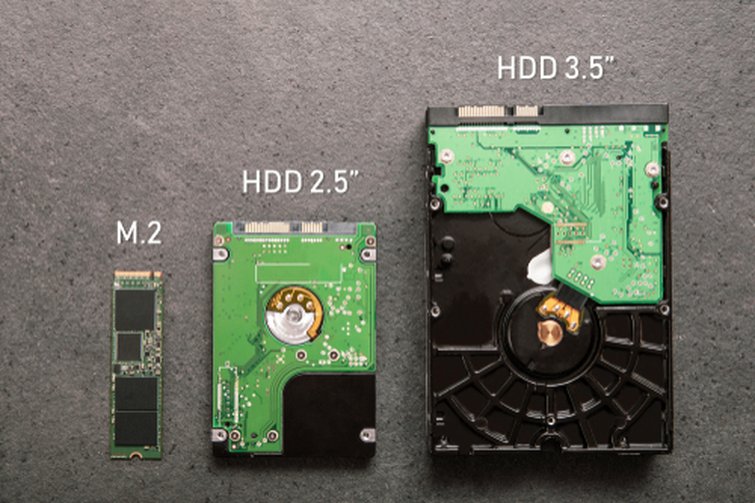
Storage drives have become smaller, faster, and more affordable. HDDs are still popular today, but SSDs with the M.2 form factor are rising in popularity. Image via Daniel Krason.
The HDD offers high storage capacities at a low price, while the SSD provides blazing fast access speeds at a higher cost. Used together, PC users can access their most important files quickly via the SSD, while storing media and other large files on their less expensive HDD.
But, before you start shopping for storage, you should know that HDDs and SSDs are not all built the same, and each type of drive has many different variables that affect storage capacity, speed, and computer compatibility. Here’s what you need to know.
How HDDs Work
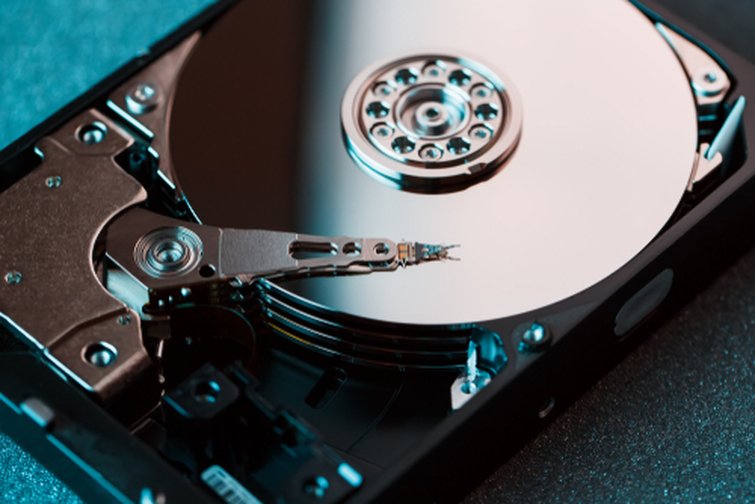
The platter, or disk, spins around at several thousand revolutions per minute as the arm reads or writes data. Faster spinning drives can access files faster. Image via Aleksandr Grechanyuk.
Inside of every HDD is an arm and a platter (a metal disk with a magnetic coating). The platter, which looks like a shiny CD, holds the storage, whereas the arm is what accesses the data. The arm has a tiny head at the tip that reads and writes data as the disk spins underneath, converting 0s and 1s into files and vice versa.
The time it takes to access data depends on the speed of the disk’s rotations per minute (RPM) — here’s how the inside of an HDD works in action. While drives have gotten smaller and faster, with larger storage capacities, the core principles of the technology have not changed much since IBM’s iteration.
Hard Disk Drives have come a long way, with several aspects of the drive becoming standard across all manufacturers. For example, desktop HDDs use the 3.5-inch form factor, whereas laptops use the smaller 2.5-inch drives. All HDDs operate in the same way, but there are two different speeds that you should be aware of when purchasing a drive.
Although there’s a wide range of speeds for HDDs, manufacturers mostly produce either 5400 RPM or 7200 RPM drives. The RPM stands for rotations per minute, meaning that a faster RPM equates to quicker reading and writing speeds.
According to Seagate, a 7200 RPM HDD is up to 33% faster than a 5400 RPM HDD when delivering data. If you have to choose between two drives with similar capacity, get the faster one. It may be a bit more expensive, but it’ll be worth it.
Sometimes, manufacturers sell drives that are faster at smaller capacities. For example, I bought a 3TB Seagate Barracuda Compute HDD, which is rated at 5400 RPM, but the same drive in the 1TB and 2TB capacities operate at 7200 RPM. At the time, I wanted a larger capacity for storing games, but now I’d rather purchase a faster drive.
With so many advances in storage technology in the last few years, there’s no reason why an HDD should be a computer’s primary drive. Large video and media files are fine to store in an HDD, but installing a computer’s operating system onto an HDD invites slow loading times across the board. Installing an SSD as the primary drive is essential for faster boot times and quick access to a computer’s operating system and programs.
How SSDs Work
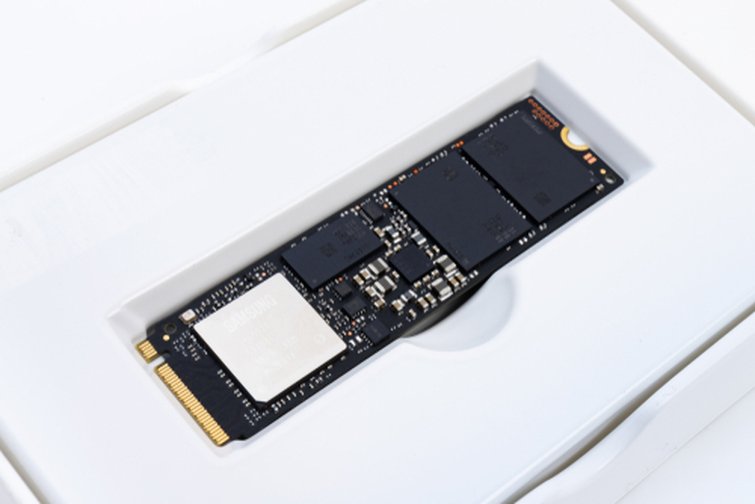
This NVMe SSD used 3D NAND flash memory modules that store data. The memory modules are the two identical black rectangles on the drive. Image via Lipowski Milan.
The main difference between both types of storage drives is that SSDs don’t use a disk to access data. Modern SSDs use flash memory modules to store data, and higher-end drives use 3D NAND flash memory modules that can store more data for cheaper. Up until a few years ago, an SSD was seen as a prosumer product, but that’s changed. Due to innovations that have increased capacity and read/write speeds, SSD use has increased within the file storage industry in recent years.
Speeds on SSDs and HDDs vary by brands, but speeds tend to stay within certain ranges. According to Enterprise Storage, a typical 7200 RMP has a read/write speed of 125MBps, SATA SSDs can read at up to 550MBps and write at 520MBps, and M.2 NVMe SSDs can reach sequential read/ write speeds of 3000MBps or more.
Standard SATA SSDs are roughly five times faster than a 7200 RPM HDD. Newer M.2 NVMe SSDs that use the PCIe 3.0 interface are up to five times faster than a standard SATA SSD and twenty-five times faster than a 7200 RPM HDD.
I’m aware that all the tech talk above looks like word soup, so I’ll break down the terms below. Knowing what all the abbreviations stand for and how they affect a storage drive can go a long way when purchasing a new drive. I made the mistake of not doing a lot of research last year, and I got stuck with slower drives. Don’t make the same mistake.
SATA 3.0 SSDs: Fast, Affordable, and Compatible with Most Computers
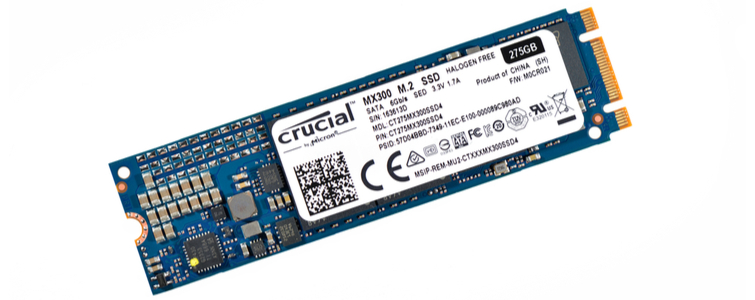
This M.2 SATA SSD is also known as a “gum stick” SSD due to its long shape. There are different-sized M.2 SSDs, but this one is a 2280 model, which is longer than other models. Image via Daniel Chetroni.
If you’re purchasing an SSD, you’ll encounter many SATA SSDs, as they’re more widespread and affordable. Most SSDs use the SATA 3.0 interface, which has a max speed of 560MBps. While SATA 3.0 SSDs are not the fastest, they’re still much faster than standard HDDs, and their lower price makes them a viable option for most users.
There are two form factors for SATA SSDs. The option that works on most computers has a 2.5-inch form factor that’s semi-thin and connects to the computer via a SATA data cable and a SATA power cable. This type of flat, rectangular SSD has a protective case. Certain PC cases include spaces to mount these types of drives, but, if not, there are mounts available online.
The other type of SSD is known as an M.2 SSD, which gets its name from the kind of interface it uses. This drive inserts directly into the motherboard via an M.2 socket, which is how it gets its power and transfers data. These drives come in different sizes, but the most common form-factor is the M.2 2280 SSD, which is longer and looks similar to a big stick of gum (see image above).
Both types of SATA 3.0 SSDs have the same sequential read/write speeds, and they cost about the same, so it’s a matter of preference. I bought an M.2 SATA 3.0 drive because my motherboard has two slots, and both of them have a heatsink cover to prevent overheating.
With Windows installed on my SSD, the computer boots within seconds, and navigating the operating system is a breeze. These days, however, I’ve been thinking of updating my boot drive — the drive where the operating system is installed — to a more expensive NVMe M.2 SSD. The upgrade will make it faster to write data and access large game or video files.
NVMe SSDs: The Fastest, Most Expensive Option
The other kind of SSDs are NVMe SSDs, and they’re even faster than standard SSDs. NVMe is not a type of interface like SATA 3.0 or PCIe 3.0, nor is it a type of memory module. NVMe is a memory controller on a drive that can quickly access the data stored. These newer NVMe SSDs use a PCIe 3.0 connector, but we’ll get to that later.
NVMe is short for Non-Volatile Memory Express, and, according to Western Digital’s blog, it’s a “highly scalable storage protocol that connects the host to the memory subsystem.” All SSDs use flash storage to store files, and the NVMe storage protocol can rapidly access those files while using less computing power, making SSD technology even faster. And, because NVMe is non-volatile, the drive does need to be powered on at all times to store data.
If you’re thinking of purchasing one of these drives to use as your boot drive, check out the Seagate video at the top of this section for a comprehensive tutorial.
PCIe 3.0 Interface: Fast Speeds for NVMe SSDs
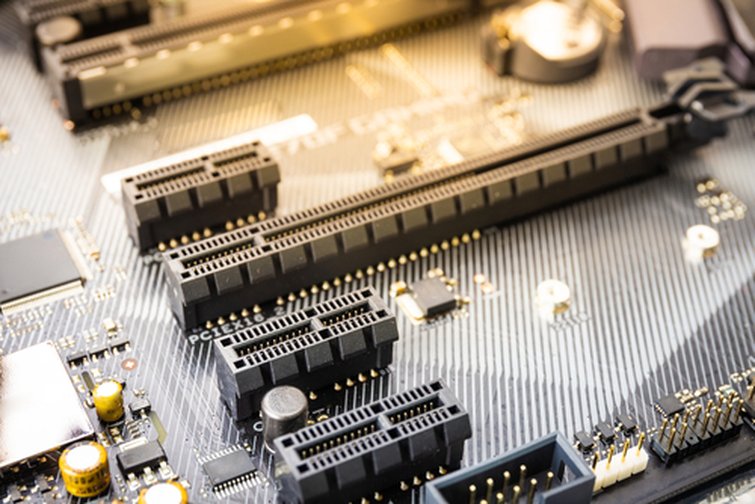
The PCIe slots on the motherboard come in different sizes and their speed may vary. M.2 SSDs with a PCIe 3.0 interface, however, don’t use these slots. Instead, they use the M.2 socket. Image via Pakpoom Phummee.
While NVMe is a memory protocol that can recall files in a much faster way, it’s the interface on the drive that gives NVMe SSDs their insane amount of speed. Peripheral Component Interconnect Express, more commonly known as PCIe, is an interface that allows computer components to transmit data and information. It’s, by far, the fastest way for computers to transfer data, and the interface is common with many hardware components.
The current PCIe standard is PCIe 3.0, which is capable of transferring 1GB/s per lane, while the newer PCIe 4.0 does double the amount — only high-end motherboards currently support PCIe 4.0 NVMe SSDs. PCIe transfer speed is denoted by x1, x2, or x4, which describes the available PCIe lanes. The more lanes available, the more data can transfer at the same time.
Modern motherboards have PCIe slots used to connect graphics cards, wireless network cards, and other components, but NVMe SSDs don’t use PCIe slots. Though PCIe slots are the most common way of accessing the PCIe lanes, NVME SSDs use the M.2 socket on the motherboard to transfer data via PCIe lanes. The fastest NVME SSDs have an “M” key that allows the drive to transfer data on four lanes (x4), resulting in a max 4GB/s transfer speed.
It’s important to know that even if an NVME SSD is capable of transferring 4GB/s, even the best drives only reach read speeds of 3.5GB/s and write speeds of 3GB/s, but those speeds vary per manufacturer. Also, not all M.2 sockets support four PCIe lanes.
When buying an NVME SSD, check your motherboard manual to make sure that the M.2 socket(s) supports M.2 drives with an “M” key, which are the only ones capable of using four (x4) lanes. Motherboards with M.2 sockets that support “B” key drives can only transfer data on two lanes. Drives with both keys (B and M) can fit on either socket, but they are also limited to only x2 transfer speeds.
M.2: Form Factor and Socket
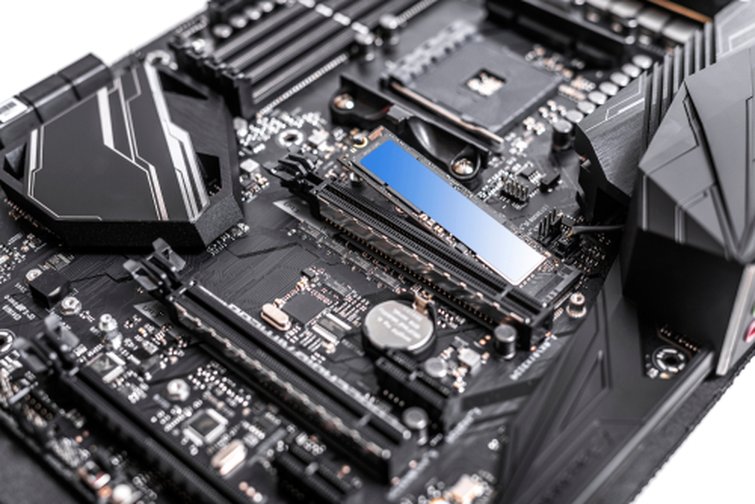
M.2 SSDs connect to the motherboard via the M.2 socket. Some motherboards may have more than one socket, while others may have none. To secure the drive, it must be inserted into the socket and screwed onto the motherboard. Image via Den Rozhnovsky.
M.2 is a form factor, and it doesn’t measure speed. The M.2 form factor is primarily used for either SATA or NVMe SSDs, which look like long, thin rectangles similar to a big stick of gum. While the M.2 design is most associated with SSDs, other types of hardware — such as wireless communications — use the M.2 form factor.
The M.2 port on a motherboard is called an M.2 socket, and the physical connection on an M.2 SSD is called a key. Some motherboards have one or two M.2 sockets, while some have none at all. More importantly, not all keys fit in the same socket. NVMe and SATA M.2 SSDs have separate keys, which aren’t interchangeable, so make sure you know what you’re buying. Again, check the motherboard manual to find out which M.2 sizes are supported.
When shopping for an SSD drive, the M.2 on the box doesn’t delineate the speed, storage capacity, or anything else. It only means that a drive looks like the image above.
You’ll notice that motherboards with M.2 sockets have screws that line up with the socket, and that’s how M.2 sockets are secured. M.2 SSDs that use the 2280 design are the most common, and most motherboards support them. Read the documentation provided with your motherboard to find out which type of M.2 drives are supported.
Instead of fixating on the M.2 name, pay attention to words such as NVMe, PCIe, SATA, and other signifiers that clearly state what kind of SSD it is. When I built my PC over a year ago, I had no idea about the different kinds of M.2 SSDs, so I ended up with a SATA SSD, which is about 20% the speed of an M.2 NVMe SSD.
Solid State Hybrid Drives (SSHD)
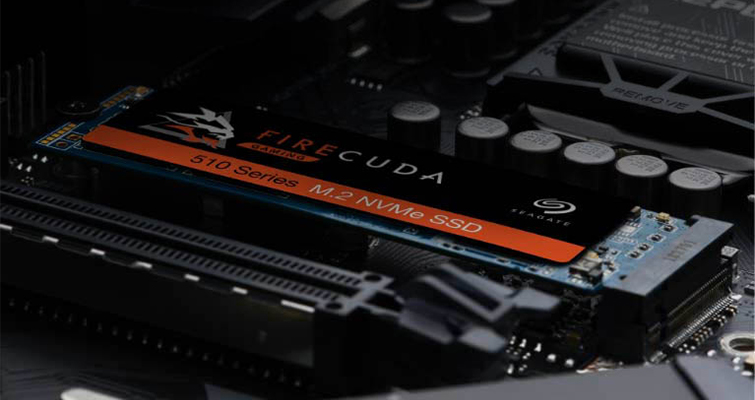
This popular hybrid drive has max read and write speeds. Image via Seagate.
Solid State Hybrid Drives are an oddball in the PC storage world, and they combine HDD and SSD tech to produce something that’s neither the most affordable nor the fastest.
Hybrid drives — such as Seagate’s FireCuda SSHDs — use a magnetic disk to store everything, while a small internal SSD caches information that’s frequently accessed. Operating system files (and other files that are accessed frequently) are stored on the SSD for quick access, while the bulk of the data remains on the HDD.
These hybrid drives use the standard SATA 3.0 interface, which is used by both HDDs and SSDs. The FireCuda SSHD is one of the most popular hybrid drives, and it has max read/write speeds of about 140MB/s — actual speeds vary by system. Booting up a computer with an SSHD is faster than with a standard disk drive, but the speed comparisons stop there. When comparing Seagates’ FireCuda SSHDs against the BarraCuda HDDs, the 7200RPM BarraCuda slightly outperforms the FireCuda in many categories, and it’s $20 cheaper.
Instead of buying an SSHD for faster boot times, consider a dual-drive system. A dual-drive has many advantages — it gives users the experience of fast boot times and a lot of storage space, all while staying on budget.
The Benefit of Using a Dual-Drive System
If you’re thinking of updating your computer, the best price-to-performance upgrade you can make (apart from a new CPU) is installing an SSD. Having an SSD onboard can dramatically reduce the time to boot, and you’ll notice the difference when loading files onto your editing software of choice.
There’s no reason why your system should boot from an HDD in 2020. And if you’re worried about price, don’t be.
I currently have a dual-drive system on my PC, and it’s the best of both worlds. I keep the operating system, editing software, and some games on the SSD. The HDD stores video files, images, the bulk of my games, and every other file.
Some motherboards support more than two drives, so you can keep adding storage to fit your needs. If you’re running out of space, just get another HDD, and if speed is more important, upgrade to a faster drive. For sure, though, install an SSD on your computer as a primary boot drive. It’ll make a world of difference.
Price Differences: Which One Is Best for Your System
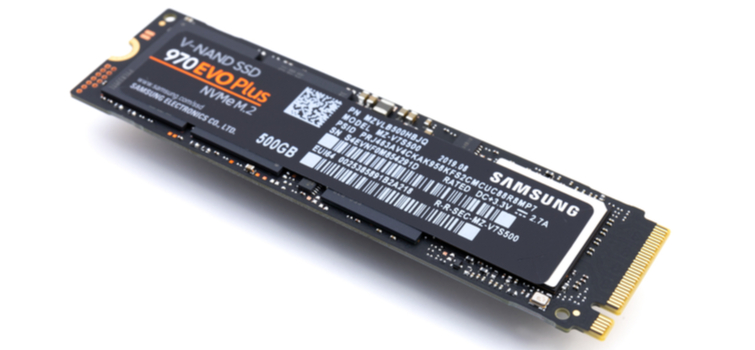
If you want the best of the best, the 970 Evo Plus is what you’re looking for, and costs over $100 for just 500GB. This drive uses the new PCIe 4.0 interface, which only works on select motherboards. The PCIe 4.0 interface can transmit up to 2GB/s on each of the four lanes. Image via Lipowski Milan.
Speed is important, and even more so when editing video. An NVMe SSD can write up to 3GB/s, which is far and beyond any other consumer-grade storage drive, and newer PCIe 4.0 SSDs are even faster. What you should consider is how much you’re willing to pay for speed.
My system uses a 500GB M.2 SATA SSD, which has sequential read/write speeds of about 500MB/s, while my 3TB 5400RPM HDD’s speed is one-fifth of the SSD. You can buy a 500GB SATA SSD right now for about $70, which you can use as your boot drive. For everything else, you can purchase an HDD for cheap these days. The Barracuda drives are some of the best around, and you can get 3TB for a little under $90.
Admittedly, I know my storage solution isn’t the fastest, but it’s served me well. And, I have another M.2 socket and a few more SATA ports if I want to upgrade down the line. I spent nearly $150 for my dual-drive system last year, and that’s equal to the price of a 1TB NVME SSD. At the moment, I can’t splurge on a drive that expensive, no matter how fast it is, but Newegg and other computer hardware retailers frequently have deals on storage.
I can’t specify which drives to buy because it varies per your system and your budget. So, if you have the money, spend it. If you don’t, shop wisely and buy what you can afford. Having a good balance of speed and storage is a better option and is likely to stay on budget. Speed is key — but it isn’t everything.
Looking for more content related to SSD and HDD storage? Start here:
- A Shortage in NAND Flash Memory Could Raise SSD Prices
- Hands-On Review: G-Technology’s G-Drive Mobile Pro SSD
- How to Build an Editing PC for Remote Work (on a Budget)
- Hardware Accelerated Encoding Coming to Premiere and After Effects
Cover image via Lenorko.

